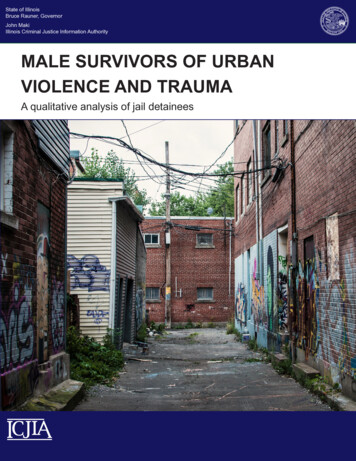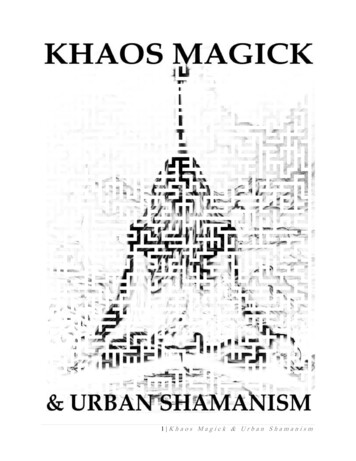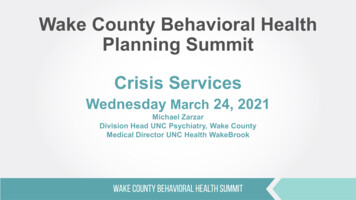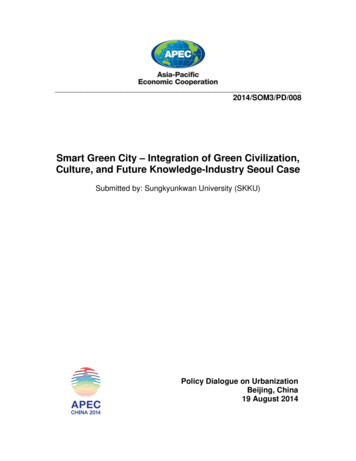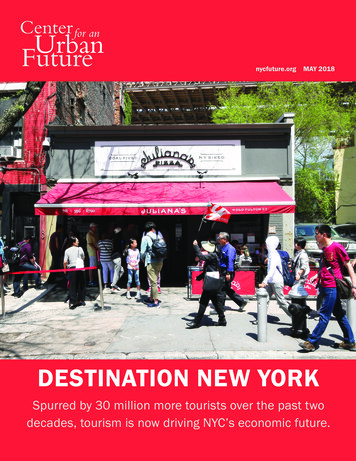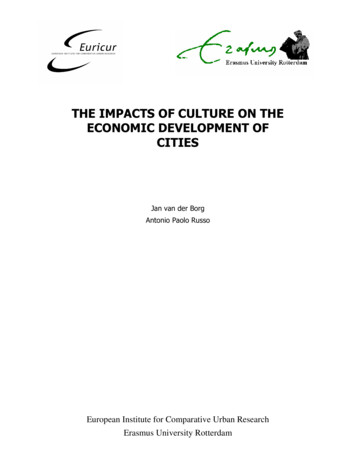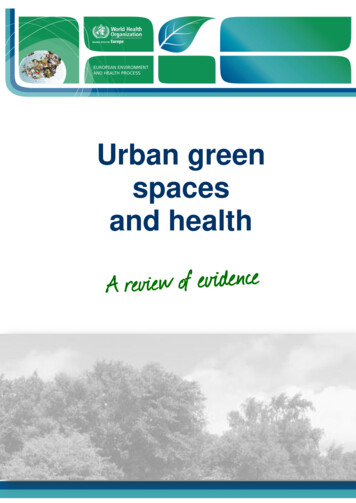
Transcription
Urban greenspacesand health
Urban greenspacesand healthA review of evidence
ABSTRACTThis report summarizes the available evidence of beneficial effects of urban green spaces, such asimproved mental health, reduced cardiovascular morbidity and mortality, obesity and risk of type 2diabetes, and improved pregnancy outcomes. Mechanisms leading to these health benefits includepsychological relaxation and stress alleviation, increased physical activity, reduced exposure to airpollutants, noise and excess heat. Characteristics of urban green spaces that are associated withspecific mechanisms leading to health benefits, and measures or indicators of green space availability,accessibility and use that have been used in previous surveys are discussed from the perspective oftheir public health relevance and applicability for monitoring progress towards goals set in internationalcommitments, such as the Parma Declaration in the WHO European Region and the global SustainableDevelopment Goals. The report also presents a suggested indicator of accessibility of green spaces withexamples of its application in three European cities and a detailed methodological tool kit for GISanalysis of land use and population data.KeywordsUrban HealthCitiesEnvironmentAddress requests about publications of the WHO Regional Office for Europe to:PublicationsWHO Regional Office for EuropeUN City, Marmorvej 51DK‐2100 Copenhagen Ø, DenmarkAlternatively, complete an online request form for documentation, health information, or for permission to quote ortranslate, on the Regional Office web site (http://www.euro.who.int/pubrequest).Citation advice:Urban green spaces and health. Copenhagen: WHO Regional Office for Europe, 2016. World Health Organization 2016All rights reserved. The Regional Office for Europe of the World Health Organization welcomes requests forpermission to reproduce or translate its publications, in part or in full.The designations employed and the presentation of the material in this publication do not imply theexpression of any opinion whatsoever on the part of the World Health Organization concerning the legalstatus of any country, territory, city or area or of its authorities, or concerning the delimitation of its frontiersor boundaries. Dotted lines on maps represent approximate border lines for which there may not yet be fullagreement.The mention of specific companies or of certain manufacturers’ products does not imply that they areendorsed or recommended by the World Health Organization in preference to others of a similar nature thatare not mentioned. Errors and omissions excepted, the names of proprietary products are distinguished byinitial capital letters.All reasonable precautions have been taken by the World Health Organization to verify the informationcontained in this publication. However, the published material is being distributed without warranty of anykind, either express or implied. The responsibility for the interpretation and use of the material lies with thereader. In no event shall the World Health Organization be liable for damages arising from its use. The viewsexpressed by authors, editors, or expert groups do not necessarily represent the decisions or the stated policyof the World Health Organization.Cover photo: OPENspace Research Centre
EditorsAndrey I. Egorov 1, 2 *, Pierpaolo Mudu 1, Matthias Braubach 1 and Marco Martuzzi 11World Health Organization, European Centre for Environment and Health, Bonn, Germany2United States Environmental Protection Agency, National Health and Environmental EffectsResearch Laboratory, Chapel Hill, North Carolina, the United States* AIE contributed to the report working at WHO and then at US EPA.Primary authorsSection 2:Catharine Ward Thompson and Eva Silveirinha de OliveiraOPENspace Research Centre, University of Edinburgh, United KingdomSection 3:Benedict W. Wheeler and Michael H. DepledgeEuropean Centre for Environment and Human Health, University of Exeter Medical School, UnitedKingdomSection 4:Matilda Annerstedt van den BoschSwedish University of Agricultural Sciences, SLU, Alnarp, and Lund University, SwedenOther contributorsThe following individuals contributed their expertise to the development of recommendations onhealth‐relevant WHO indicators of urban green space and commented on the draft report:Mark Nieuwenhuijsen, Center for Research in Environmental Epidemiology (CREAL), Barcelona, SpainSjerp De Vries, Research Institute Alterra, Wageningen University, Wageningen, The NetherlandsThomas Claßen, University of Bielefeld School of Public Health, Bielefeld, GermanyJenny Roe, University of Virginia School of Architecture, Charlottesville, Virginia, the United StatesHanneke Kruize, Dutch National Institute for Public Health and the Environment (RIVM), Bilthoven,The NetherlandsFrancesca Racioppi, WHO Regional Office for Europe, Copenhagen, DenmarkTanja Wolf, WHO Regional Office for Europe, Bonn, GermanyKristen Scott, Intern at the WHO Regional Office for Europe, Bonn, GermanyAnne Cleary, Intern at the WHO Regional Office for Europe, Bonn, Germany.AcknowledgementGlenn Rice, US Environmental Protection Agency, reviewed the report and made valuable comments.iii
DisclaimerThe views expressed in this report are those of the authors and do not necessarily reflect the viewsor policies of the U.S. Environmental Protection Agency. Mention of trade names or commercialproducts does not constitute endorsement or recommendation for use.iv
List of abbreviationsADHDAttention Deficit Hyperactivity DisorderBME (groups)black and minority ethnic (groups)CORINECoordination of Information on the EnvironmentEEAEuropean Environment AgencyEEGElectroencephalographyEUEuropean UnionGISGeographic Information SystemGPSGlobal Positioning SystemNDVINormalized Difference Vegetation IndexUV (light)ultraviolet (light)US EPAUnited States Environmental Protection AgencyWHOWorld Health Organizationv
Table of contents1. INTRODUCTION . 12. EVIDENCE ON HEALTH BENEFITS OF URBAN GREEN SPACES . 32.1 Definitions of urban green space . 32.2 Pathways linking urban green space to improved health and well‐being . 32.2.1 Overview of pathways to health . 32.2.2 Improved relaxation and restoration . 42.2.3 Improved social capital . 52.2.4 Improved functioning of the immune system . 52.2.5 Enhanced physical activity, improved fitness and reduced obesity . 52.2.6 Anthropogenic noise buffering and production of natural sounds . 72.2.7 Reduced exposure to air pollution . 82.2.8 Reduction of the urban heat island effect . 82.2.9 Enhanced pro‐environmental behaviour . 82.2.10 Optimized exposure to sunlight and improved sleep . 92.3 Evidence of health benefits of green spaces . 92.3.1 Improved mental health and cognitive function . 92.3.2 Reduced cardiovascular morbidity . 102.3.3 Reduced prevalence of type 2 diabetes . 112.3.4 Improved pregnancy outcomes . 112.3.5 Reduced mortality . 112.4 Mechanisms of potential pathogenic effects of green spaces . 122.4.1 Increased exposure to air pollutants . 122.4.2 Risk of allergies and asthma . 122.4.3 Exposure to pesticides and herbicides . 122.4.4 Exposure to disease vectors and zoonotic infections . 132.4.5 Accidental injuries . 132.4.6 Excessive exposure to UV radiation . 132.4.7 Vulnerability to crime . 132.5 Characteristics of urban green space associated with specific health benefits or hazards . 142.5.1 Perceptions of green space accessibility and quality . 142.5.2 Size of green space . 152.5.3 Presence of specific facilities for certain activities . 152.5.4 Tree cover and canopy density . 152.6 Differential health benefits of green spaces in specific population groups . 162.6.1 Women. 162.6.2 Children and adolescents . 172.6.3 Older adults . 172.6.4 Deprived subpopulations and minority groups . 182.6.5 Populations of various countries and geographic regions. 192.7 Co‐benefits of urban green spaces unrelated to health effects . 193. INDICATORS OF URBAN GREEN SPACE AVAILABILITY, ACCESSIBILITY AND USAGE, .AND ASSESSMENT OF THEIR HEALTH RELEVANCE . 213.1 Classification of urban green space indicators . 21vi
3.2 Green space characteristics that can be incorporated in definitions of indicators . 213.3 Indicators of green space availability . 223.3.1 Greenness, measured by Normalised Difference Vegetation Index (NDVI) . 223.3.2 Density or percentage of green space by area . 233.3.3 Measures of street trees and other streetscape greenery . 243.4 Indicators of green space accessibility . 253.4.1 Proximity to an urban park or geographically defined green space . 253.4.2 Proportion of green space or greenness within a certain distance from residence . 263.4.3 Perception‐based measures of green space accessibility . 273.5 Indicators of green space usage . 283.6 Summary and recommendations for a health‐relevant approach to selecting .and using indicators of urban green space . 293.6.1 Summary of considerations for selecting indicators . 293.6.2 Recommendations for a primary indicator . 303.6.3 Recommendations for secondary indicators . 314. PROPOSED INDICATOR AND A DATA ANALYSIS TOOL KIT . 324.1. Summary of indicator development and evaluation . 324.2. Data requirements for a WHO Urban Green Space Indicator . 334.2.1. Land use data for EU countries . 334.2.2. Land cover/use data for non‐EU countries. 344.2.3 Population data . 344.3. Methodology . 344.3.1 General overview . 344.3.2 Basic method . 364.3.3. Complex method . 384.4 Summary of the proposed indicator . 395. CONCLUSIONS . 406. LITERATURE . 42APPENDIX 1. Examples of definitions related to assessing green space availability or accessibility . 64APPENDIX 2. The availability of key urban land use data for the Member States of .the WHO European Region . 65APPENDIX 3: A tool kit for assessing green space accessibility – detailed step‐by‐step procedure . 67vii
viii
1. INTRODUCTIONThere is a recent revival of interest in the importance of green space to support healthy living inurban areas. Links between green space and health have been recognized throughout history, andwere one of the driving forces behind the urban parks movement of the 19th century in Europe andNorth America (Schuyler, 1988).However, many of the mechanisms behind such links were poorly understood or lacked rigorousscientific evidence. In the 21st century, new research techniques provide opportunities to study themechanisms behind associations between green space and health with increasing sophistication andhelp satisfy contemporary scientific standards of evidence demanded to inform policy and practice.This refined understanding of the health promotion potential of urban green spaces can contributeto addressing major public health issues related to noncommunicable diseases. Across Europe andbeyond, preventable noncommunicable diseases, such as mental illness, obesity, cardiovasculardiseases, type 2 diabetes and cancer, remain major factors not only affecting health and well‐being,but also driving up the cost of health care and reducing the productivity of the workforce. Many suchillnesses are linked to chronic stress and lifestyle factors, such as insufficient physical activity (Shorttet al., 2014). Urban green spaces, as part of a wider environmental context, have the potential tohelp address problems ‘upstream’, in a preventative way – considered a more efficient approachthan simply dealing with the ‘downstream’ consequences of ill health (Morris et al., 2006).At the Fifth Ministerial Conference on Environment and Health in Parma, Italy (2010), the MemberStates of the WHO European Region made a commitment “ to provide each child by 2020 withaccess to healthy and safe environments and settings of daily life in which they can walk and cycle tokindergartens and schools, and to green spaces in which to play and undertake physical activity”(WHO, 2010b). Improving access to green spaces in cities is also included in the United NationsSustainable Development Goal 11.7, which aims to achieve the following: “By 2030, provide universalaccess to safe, inclusive and accessible, green and public spaces, in particular for women and children,older persons and persons with disabilities” (United Nations Department of Economic and SocialAffairs, 2014). Finally, the WHO Action Plan for the implementation of the European Strategy for thePrevention and Control of Noncommunicable Diseases in 2012 2016 includes a call to create health‐supporting urban environments (WHO, 2012).Previous WHO reports have already contributed evidence and guidance on access to green space inrelation to public health benefits. A WHO report on urban planning, environment and healthpublished in 2010 states that green spaces can positively affect physical activity, social andpsychological well‐being, improve air quality and reduce exposure to noise; however, they can alsobe associated with an increased risk of injury due to increased recreational and sport‐related use(WHO, 2010d). Another WHO report evaluated the effects of green spaces on physical activity andtheir potential to reduce public health inequalities. It states that “ access to public open space andgreen areas with appropriate recreation facilities for all age groups is needed to support activerecreation”, but recognizes that multidisciplinary and intersectoral interventions may be needed tosupport disadvantaged groups where physical activity levels are lowest (WHO, 2013).Recent studies have provided evidence of multiple benefits from urban green space, through variousmechanisms, and with potentially differential impacts in various populations. Epidemiological studieshave used a multitude of approaches to measure the effects of urban green space availability andaccessibility on the health outcomes of study participants. Given the potential of urban green spacesto act as settings for health promotion it is therefore necessary to summarize the existing evidenceidentifying, where possible, the underlying mechanisms contributing to both the negative andpositive health outcomes of urban green space. There is also a need to summarize existingunderstandings of the characteristics of urban green space that may differentially be associated with1
health outcomes, and to understand how different populations may be affected and benefit indifferent ways.This report offers a review of the existing evidence on the health effects of green space in urbanareas alongside a summary of health‐relevant measures of green space availability, accessibility andusage. The report also presents a toolkit outlining an example of a Geographic Information System(GIS)‐based approach to measuring urban green space that WHO has recently applied in threeEuropean cities (Annerstedt van den Bosch et al., 2016). The review is not systematic but, rather, anoverview of previous WHO reports and other previously published reviews as well as selected recentresearch publications. The main objectives of this report are to inform public health specialists andpolicy‐makers on the benefits of providing urban residents with green space access, and to providecities with systematic approaches to quantifying and monitoring their green space access. In doing sothis report advocates the implementation and evaluation of targeted, evidence‐based green spaceinterventions for the health promotion of urban residents.2
2. EVIDENCE ON HEALTH BENEFITS OF URBAN GREEN SPACESThis section summarizes the evidence of pathways to health and health benefits of urban greenspace focusing particularly on research published over the last 10 years. Potential mechanisms bywhich green space may affect public health are discussed first, followed by specific health benefitsdemonstrated by epidemiological studies and, finally, potential detrimental effects.2.1 Definitions of urban green spaceCurrently, there is no universally accepted definition of urban green space, with regard to its healthand well‐being impacts. Urban green spaces may include places with ‘natural surfaces’ or ‘naturalsettings’, but may also include specific types of urban greenery, such as street trees, and may alsoinclude ‘blue space’ which represents water elements ranging from ponds to coastal zones. Typicalgreen spaces in urban areas are public parks; other definitions may also include private gardens,woodlands, children’s play areas, non‐amenity areas (such as roadside verges), riverside footpaths,beaches, and so on. The definitions are nuanced and context‐specific. For example, they can dependon particular environment‐health pathways under consideration. Examples of green space definitionsare presented in Appendix 1.The following review of health benefits as well as discussion of green space measures and indicatorsin Section 3 of the report summarize all available evidence and experience based on variousdefinitions of urban green space, reflecting varying ways in which it is described and defined indifferent studies.Consideration of urban green space in different research usually includes public parks and gardens,but may or may not also include a range of other areas, such as other public open space, street trees,sports pitches and recreational facilities such as golf courses, private and semi‐private gardens andother residential open space, roof gardens, urban agriculture, commercial forests, vegetated wasteland, indeed any place where there is a natural surface or where trees are growing.The most common definition of urban green space that has been used in studies in Europe is basedon the definition from the European Urban Atlas (European Union, 2011). The Green Urban Areas asdefined by Urban Atlas code 14100 include public green areas used predominantly for recreationsuch as gardens, zoos, parks, and suburban natural areas and forests, or green areas bordered byurban areas that are managed or used for recreational purposes. In policy terms, it is important tofocus on urban green space that is open to the public particularly when considering universal greenspace access for all urban residents, regardless of socioeconomic circumstances. However, whererelevant the overview includes studies that have used wider or more inclusive definitions of urbangreen space.While the Urban Atlas excludes bodies of water from the definition of Green Urban Areas, werecognize that water is often part of urban green space and that the water edge, whether, forexample, along a river or lake, a sea beach or a cliff, is often an important and attractive feature forpeople to use and enjoy. For this reason, we might consider the working definition for urban greenspace used in this overview to include ‘green/blue’ space which may be of benefit in its entirety, andwhere the riparian zone and access to water may be particularly valued and used by urban dwellers.This overview does not, however, include studies that are explicitly focused on the health benefits ofwater‐based sports and recreation.2.2 Pathways linking urban green space to improved health and well‐being2.2.1 Overview of pathways to healthThe mechanisms underlying links between green space access and health are likely to be complexand interacting. Access to green space may produce health benefits through various pathways(mechanisms leading to health effects), some of which may have a synergistic effect. Various models3
have been proposed to explain the observed relationship between green space and health. Hartig etal. (2014) suggested four principal and interacting pathways through which nature or green spacemay contribute to health: improved air quality, enhanced physical activity, stress reduction andgreater social cohesion. Lachowycz & Jones (2013) emphasized physical activity, engagement withnature and relaxation, and social activities and interactions as major pathways to health. Villanuevaet al. (2015) proposed a model that emphasizes respiratory health and resilience to heat‐relatedillness, social capital and cohesion, and physical activity. Kuo (2015) suggests a central role forenhanced immune functioning as a pathway between nature and health, recognizing that there maybe multiple pathways, some of which may interact and offer both direct and indirect benefits. Hartiget al. (2014) summarized the existing strong evidence for restorative psychological effects frominteraction with green space or natural environments.2.2.2 Improved relaxation and restorationIt has been recognized for centuries that contact with nature can be restorative and evidence ofmental health benefits from having contact with nature and green spaces is well documented (Hartig,2007; Hartig et al., 1991). There are two main theories that attempt to explain this:a) Psycho‐physiological stress reduction theory proposes that contact with nature (e.g. views ofnatural settings) can have a positive effect for those with high levels of stress, by shifting them to amore positive emotional state (Ulrich, 1983; Ulrich et al., 1991). As people are innately predisposedto find non‐threatening natural stimuli relaxing, exposure to these stimuli triggers a parasympatheticnervous system response leading to feelings of enhanced well‐being and relaxation.b) Attention Restoration Theory suggests that involuntary attention given to interesting and richstimuli in natural settings helps to improve performance in cognitively demanding tasks (Kaplan andKaplan, 1989; Kaplan, 1995; Kaplan, 2001; Kaplan and Kaplan, 2011). People have two types ofattention: directed attention, which requires effort and, therefore, is a limited resource, andfascination or effortless involuntary attention. Working on specific tasks requiring direct attentiondepletes this limited resource while involuntary attention, which is facilitated in naturalenvironments, restores it and, therefore, improves cognitive performance.Both are psycho‐evolutionary theories, based on the biophilia hypothesis, which postulates thathumans have an innate need to affiliate with the natural environment within which they haveevolved (Wilson, 1984). Both theories suggest that interaction with the natural environment serve arestorative function but through different mechanisms (reviewed by Clatworthy et al., 2013).Support for these theories has been provided by studies that demonstrate restorative physiologicalresponses associated with viewing or being in green space, including reduced blood pressure (Hartiget al., 2003, Ottosson & Grahn, 2005, Ulrich et al., 1991), heart rate (Ottosson & Grahn, 2005, Ulrichet al., 1991), skin conductance and muscle tension (Ulrich et al., 1991). Evidence ofpsychoneuroendocrine responses to woodland environments are based on observed associationswith lower concentrations of cortisol, lower pulse rate, lower blood pressure, greaterparasympathetic nerve activity and lower sympathetic nerve activity when compared to cityenvironments (Lee et al., 2011; Park et al., 2007).Hartig et al. (2014) noted that “substantial evidence speaks to the potential benefits of contact withnature for avoiding health problems traceable to chronic stress and attentional fatigue”, but alsopointed out that most previously conducted studies demonstrated only short‐term restorativebenefits of an episode of experiencing nature. For example, a study in the United Kingdom usedwearable electroencephalography (EEG) devices to demonstrate the effects of a short walk in a greenspace on brain activity that might be associated with enhanced relaxation and restoration (Aspinall etal., 2015). It was also shown that walking in natural environments produces stronger short‐termcognitive benefits than walking in the residential urban environment (Gidlow et al., 2016a). Using thediurnal cortisol pattern as a biomarker of chronic stress is an innovative approach that was applied in4
the United Kingdom to demonstrate that exposure to green space reduces chronic stress in adultsliving in deprived urban neighbourhoods (Roe et al., 2013, Ward Thompson et al., 2012; Beil & Hanes2013). Similar relationships between green space and stress reduction have been shown using haircortisol as a biomarker of chronic stress (Honold et al., 2016; Gidlow et al., 2016b). Cortisol measureshave also demonstrated the stress reducing effects of gardening (van den Berg & Custer, 2011)suggesting that such activities in green space may be particularly restorative. It has also beendemonstrated that exposure to green spaces reduces neural activity in the subgenual prefrontalcortex and alleviates de
iii Editors Andrey I. 1,Egorov 2 *, Pierpaolo 1Mudu 1, Matthias Braubach and Marco Martuzzi 1 1 World Health Organization, European Centre forEnvironmentand Health,Bonn, Germany 2 United States EnvironmentalProtection Agency, National Health and Effects Research Labor


